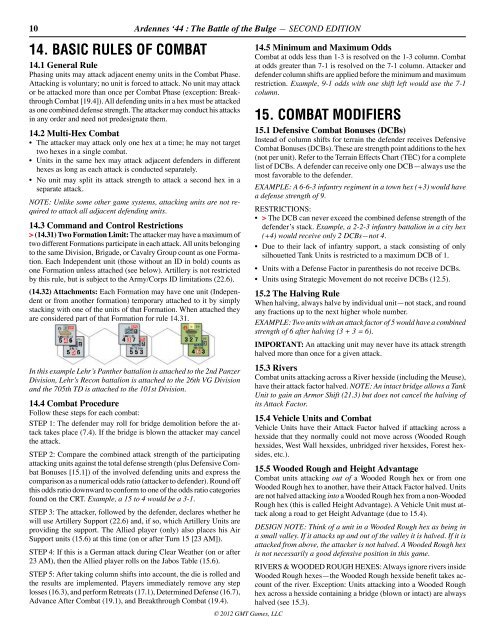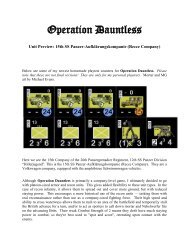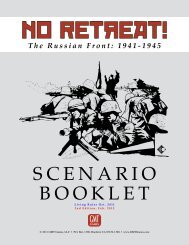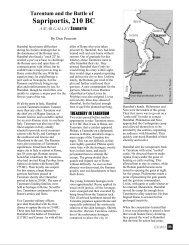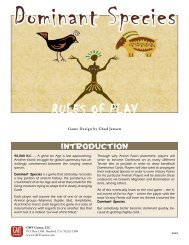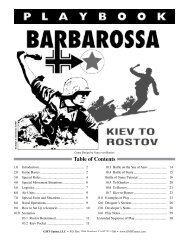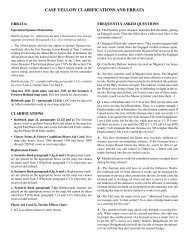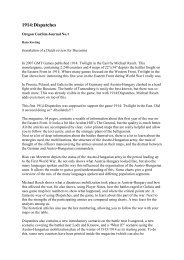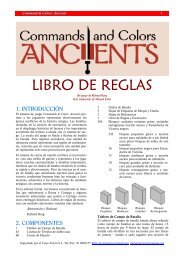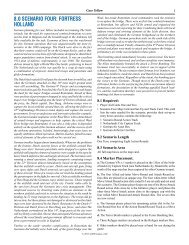You also want an ePaper? Increase the reach of your titles
YUMPU automatically turns print PDFs into web optimized ePapers that Google loves.
10 Ardennes ‘44 : The Battle of the Bulge — SECOND EDITION<br />
14. BASIC RULES OF COMBAT<br />
14.1 General Rule<br />
Phasing units may attack adjacent enemy units in the Combat Phase.<br />
Attacking is voluntary; no unit is forced to attack. No unit may attack<br />
or be attacked more than once per Combat Phase (exception: Breakthrough<br />
Combat [19.4]). All defending units in a hex must be attacked<br />
as one combined defense strength. The attacker may conduct his attacks<br />
in any order and need not predesignate them.<br />
14.2 Multi-Hex Combat<br />
• The attacker may attack only one hex at a time; he may not target<br />
two hexes in a single combat.<br />
• Units in the same hex may attack adjacent defenders in different<br />
hexes as long as each attack is conducted separately.<br />
• No unit may split its attack strength to attack a second hex in a<br />
separate attack.<br />
NOTE: Unlike some other game systems, attacking units are not required<br />
to attack all adjacent defending units.<br />
14.3 Command and Control Restrictions<br />
> (14.31) Two Formation Limit: The attacker may have a maximum of<br />
two different Formations participate in each attack. All units belonging<br />
to the same Division, Brigade, or Cavalry Group count as one Formation.<br />
Each Independent unit (those without an ID in bold) counts as<br />
one Formation unless attached (see below). Artillery is not restricted<br />
by this rule, but is subject to the Army/Corps ID limitations (22.6).<br />
(14.32) Attachments: Each Formation may have one unit (Independent<br />
or from another formation) temporary attached to it by simply<br />
stacking with one of the units of that Formation. When attached they<br />
are considered part of that Formation for rule 14.31.<br />
In this example Lehr’s Panther battalion is attached to the 2nd Panzer<br />
Division, Lehr’s Recon battalion is attached to the 26th VG Division<br />
and the 705th TD is attached to the 101st Division.<br />
14.4 Combat Procedure<br />
Follow these steps for each combat:<br />
STEP 1: The defender may roll for bridge demolition before the attack<br />
takes place (7.4). If the bridge is blown the attacker may cancel<br />
the attack.<br />
STEP 2: Compare the combined attack strength of the participating<br />
attacking units against the total defense strength (plus Defensive Combat<br />
Bonuses [15.1]) of the involved defending units and express the<br />
comparison as a numerical odds ratio (attacker to defender). Round off<br />
this odds ratio downward to conform to one of the odds ratio categories<br />
found on the CRT. Example, a 15 to 4 would be a 3-1.<br />
STEP 3: The attacker, followed by the defender, declares whether he<br />
will use Artillery Support (22.6) and, if so, which Artillery Units are<br />
providing the support. The Allied player (only) also places his Air<br />
Support units (15.6) at this time (on or after Turn 15 [23 AM]).<br />
STEP 4: If this is a German attack during Clear Weather (on or after<br />
23 AM), then the Allied player rolls on the Jabos Table (15.6).<br />
STEP 5: After taking column shifts into account, the die is rolled and<br />
the results are implemented. Players immediately remove any step<br />
losses (16.3), and perform Retreats (17.1), Determined Defense (16.7),<br />
Advance After Combat (19.1), and Breakthrough Combat (19.4).<br />
© 2012 <strong>GMT</strong> <strong>Games</strong>, LLC<br />
14.5 Minimum and Maximum Odds<br />
Combat at odds less than 1-3 is resolved on the 1-3 column. Combat<br />
at odds greater than 7-1 is resolved on the 7-1 column. Attacker and<br />
defender column shifts are applied before the minimum and maximum<br />
restriction. Example, 9-1 odds with one shift left would use the 7-1<br />
column.<br />
15. COMBAT MODIFIERS<br />
15.1 Defensive Combat Bonuses (DCBs)<br />
Instead of column shifts for terrain the defender receives Defensive<br />
Combat Bonuses (DCBs). These are strength point additions to the hex<br />
(not per unit). Refer to the Terrain Effects Chart (TEC) for a complete<br />
list of DCBs. A defender can receive only one DCB—always use the<br />
most favorable to the defender.<br />
EXAMPLE: A 6-6-3 infantry regiment in a town hex (+3) would have<br />
a defense strength of 9.<br />
RESTRICTIONS:<br />
• > The DCB can never exceed the combined defense strength of the<br />
defender’s stack. Example, a 2-2-3 infantry battalion in a city hex<br />
(+4) would receive only 2 DCBs—not 4.<br />
• Due to their lack of infantry support, a stack consisting of only<br />
silhouetted Tank Units is restricted to a maximum DCB of 1.<br />
• Units with a Defense Factor in parenthesis do not receive DCBs.<br />
• Units using Strategic Movement do not receive DCBs (12.5).<br />
15.2 The Halving Rule<br />
When halving, always halve by individual unit—not stack, and round<br />
any fractions up to the next higher whole number.<br />
EXAMPLE: Two units with an attack factor of 5 would have a combined<br />
strength of 6 after halving (3 + 3 = 6).<br />
IMPORTANT: An attacking unit may never have its attack strength<br />
halved more than once for a given attack.<br />
15.3 Rivers<br />
Combat units attacking across a River hexside (including the Meuse),<br />
have their attack factor halved. NOTE: An intact bridge allows a Tank<br />
Unit to gain an Armor Shift (21.3) but does not cancel the halving of<br />
its Attack Factor.<br />
15.4 Vehicle Units and Combat<br />
Vehicle Units have their Attack Factor halved if attacking across a<br />
hexside that they normally could not move across (Wooded Rough<br />
hexsides, West Wall hexsides, unbridged river hexsides, Forest hexsides,<br />
etc.).<br />
15.5 Wooded Rough and Height Advantage<br />
Combat units attacking out of a Wooded Rough hex or from one<br />
Wooded Rough hex to another, have their Attack Factor halved. Units<br />
are not halved attacking into a Wooded Rough hex from a non-Wooded<br />
Rough hex (this is called Height Advantage). A Vehicle Unit must attack<br />
along a road to get Height Advantage (due to 15.4).<br />
DESIGN NOTE: Think of a unit in a Wooded Rough hex as being in<br />
a small valley. If it attacks up and out of the valley it is halved. If it is<br />
attacked from above, the attacker is not halved. A Wooded Rough hex<br />
is not necessarily a good defensive position in this game.<br />
RIVERS & WOODED ROUGH HEXES: Always ignore rivers inside<br />
Wooded Rough hexes—the Wooded Rough hexside benefit takes account<br />
of the river. Exception: Units attacking into a Wooded Rough<br />
hex across a hexside containing a bridge (blown or intact) are always<br />
halved (see 15.3).


